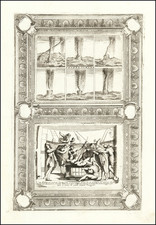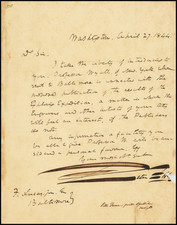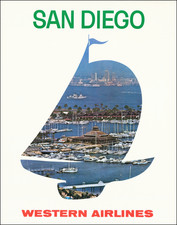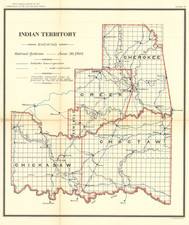George Catlin and the Indian guide, covered in wolf skins and with weapons at the ready, creep up on a herd of buffalo.
The artist painted several versions of this theme, inspired by his lament that:
“the poor buffaloes have their enemy man, besetting and besieging them at all times of the year and in all the modes that man . . . has been able to devise for their destruction. They struggle in vain to evade his deadly shafts . . . While the herd of buffaloes are together, they seem to have little dread of the wolf, and allow them to come in close company with them. The Indian then has taken advantage of this fact, and often places himself under the skin of this animal, and crawls for half a mile or more on his hands and knees, until he approaches within a few rods of the unsuspecting group, and easily shoots down the fattest of the throng.” (Catlin, Letters and Notes, vol. 1, no. 31, 1841; reprint 1973)
In 1827, George Catlin, an illustrator from Philadelphia, became the first artist to ascend the Missouri River, and the first to create visual records of his experiences traveling among the Plains Indians of North America. Catlin embarked upon his most famous journey in the Spring of 1832, traveling from St. Louis up the Missouri on the steamboat Yellowstone to Fort Union, at the intersection of the Yellowstone and Missouri rivers. It was a path that Karl Bodmer was also to follow just a year later, leading along a series of trading posts that served as a conduit for the furs and pelts brought down from the Rocky Mountains and channeled east.
Catlin's North American Indian Portfolio is one of the most important accounts of Native American life. In the preface, Catlin describes how the sight of several tribal chiefs in Philadelphia led to his resolution to record their way of life: "the history and customs of such a people, preserved by pictorial illustrations, are themes worthy of the lifetime of one man, and nothing short of the loss of my life shall prevent me from visiting their country and becoming their historian". He saw no future for either their way of life or their very existence, and with these thoughts always at the back of his mind he worked, against time, setting himself a truly punishing schedule, to record what he saw. From 1832 to 1837 he spent the summer months sketching the tribes and then finished his pictures in oils during the winter. The record he left is unique, both in its breadth and also in the sympathetic understanding that his images constantly demonstrate. A selection of the greatest of images from this record were published in the North American Indian Portfolio in an effort to reach as wide an audience as possible.
The present example is from the London edition of Catlin's seminal work. First issued in London in 1844, Catlin's work is one of the great 19th Century illustrated works and a seminal piece for Americana collectors.









![[Report and] Map of an Exploring Expedition to The Rocky Mountains in the Years 1842 and to Oregon & North California in the Years 1843-44 By Brevet Capt. J. C. Fremont of the Corps of Topographical Engineers . . .](https://storage.googleapis.com/raremaps/img/small/88488.jpg)
![(Asian Stereotypes) [Scrapbook of Ching Chow comic strip clippings]](https://storage.googleapis.com/raremaps/img/small/88894.jpg)



